If in the bathhouse it was “lucky” to install a tank for hot water from metals subject to corrosion, you need to be prepared that sooner or later rust will appear inside the tank. Water will get an unpleasant yellow color, a specific smell will appear. But how to deal with the problem? This is not difficult: it is enough to clean up the corrosion and paint the tank for hot water from the inside.
- What can be painted
- Ethyl silicate with the addition of zinc powder
- Center
- Zinc-filled anti-corrosion enamel
- Marmot iron dyes
- Epoxy enamel
- Heat-resistant water-dispersion heat-resistant materials
- A mixture of liquid glass and aluminum powder
- A mixture of lime and cement
- Preliminary processing
- Cleaning
- Degreasing
- Corrosion Treatment
- Padding
- Painting process

What can be painted
There are many heat and moisture resistant paints with which you can permanently protect the hot water tank in the bath by painting it inside. These dyes include the following types.
Ethyl silicate with the addition of zinc powder
Available in two components: ethyl silicate base and zinc powder, which must be mixed before painting the surface. After a day of drying, you can heat the water in the tank without fear of damaging the paintwork.
to contents ↑Important! All preparatory work before painting with an ethyl silicate composition must be completed at least 6 hours before the start of painting. For full polymerization of the dye, a temperature from minus 15 to plus 40 ° C is suitable.
Center
Unpretentious heat and moisture resistant paint that can withstand exposure to hot water for 7 years. This dye is used to paint inside containers at gas and oil refineries. It not only withstands high temperatures and humidity, but also has resistance to most chemical elements. The decision to paint the tank in the bath with this enamel will be the best solution to prevent corrosion damage.
to contents ↑Zinc-filled anti-corrosion enamel
When applied, a durable film of gray-steel color is formed, capable of withstanding large mechanical stresses. The best option for painting a water-containing container from the inside, it will be if the tank is open and hot water is scooped from the bucket. Hitting the bucket against the walls of the vessel will not harm the painted surface.
Marmot iron dyes
On the shelves of shops you can find many different options for this paint, which have high moisture resistance and corrosion protection. Most of these coloring preparations are heat-resistant, able to withstand temperatures up to 300 ° C. When purchasing meerk preparations, you should carefully study the instructions on the package. Any of the heat-resistant dyes will be a suitable solution for painting a hot water tank inside.
to contents ↑Epoxy enamel
Able to withstand temperature extremes from -50 to + 120 ° C and exposure to most chemical compounds. Contain passivating (inhibiting rust) elements.
Heat-resistant water-dispersion heat-resistant materials
Able to withstand heating to 120 ° C.Chemical reactions do not occur inside the container painted with such a composition, and the liquid after heating can be used not only for hygiene needs, but also for drinking.
A mixture of liquid glass and aluminum powder
Previously, before the appearance of heat- and moisture-resistant paints and varnishes, it was considered the best way to protect the tank, but now this method is used only for treating the internal surfaces of water-containing containers. A mixture of glass and aluminum withstands heating up to 700 ° C, does not affect the composition of water and is environmentally friendly. It is believed that the liquid from a tank painted with such a composition can even be used for drinking even after heating.
to contents ↑A mixture of lime and cement
It is made in a ratio of 1: 1. You can paint a container in the bath for heating water in this way. Diluted with water to a porridge consistency, the mixture is applied to the walls from the inside, dried, and this step is repeated 5-7 times. The protective properties of this composition are low, so it is now rarely used.
Preliminary processing
Just painting the tank is not enough. If it is not prepared beforehand, then all the work will be useless: when the water inside the tank is heated, the dye will begin to peel off in pieces, polluting the water masses. To prevent this, before painting the surface from the inside is recommended:
- clean from rust, dirt and scale;
- degrease;
- treat with anticorrosive agents (if there are traces of rust);
- primer if necessary (most dyes with corrosion protection are primer enamels combining the qualities of these two products).
Cleaning
It is recommended to clean the inside of the water tank in the bath by mechanical means. To do this, you can use:
- hard metal brush;
- a grinding machine with a nozzle for cleaning metal.
Traces of scale, water sediment are carefully removed from the metal base, traces of rust are cleaned. After thorough cleaning, the dishes are first washed with detergent, and then rinsed.
If you plan to paint a new tank for the prevention of corrosion damage, you can simply rinse and rinse it. After rinsing, wipe the inner walls dry with a rag and allow them to dry a little.
to contents ↑Degreasing
No matter how high-quality the wash, there is always a risk that grease stains will remain on the metal base, which will impair the adhesion of the anti-rust preparations, which means that the metal protection will be incomplete. For degreasing apply:
- White spirit and other alcohol-containing solutions. They are convenient in that they do not leave a smell after drying.
- Gasoline and solvents. All fatty traces are qualitatively removed, but for the first time after painting, the water in the tank may have a specific smell.
The degreaser is applied to the metal base and left to dry completely.
to contents ↑Corrosion Treatment
If rust has already appeared, then its further development can be stopped using anticorrosive agents. When choosing a drug, it is important to consider not only the method of influencing corrosion, but also its compatibility with the finish dye. For processing, it is customary to use:
- Insulating agents, which cover the surface with a strong film, preventing access to liquids. Most often, insulators are made on the basis of meerk whitewash and are an ideal substrate for meerk paints.
- Passivating, slowing down rusting. Perfectly combined with epoxy enamels and paints. Often, epoxy dyes combine the quality of a protective solution, primer and paint, and the finish with such products is applied immediately after degreasing.
- Protectors containing the smallest metal particles and when dried create a metallized film. Processing with this tool is well suited if it is planned to cover the inner walls with a mixture of glass and aluminum powder.
- Compounds with phosphoric acid. The content of orthophosphoric acid in the preparation allows the composition not only to prevent the appearance of rust, but also to “heal” the damage that has already occurred, turning the iron oxide (rust product) into strong and inert iron phosphate that is inert to chemical compounds. Orthophosphoric compounds are recommended for deep corrosion that has thinned the wall of the tank.
- If you plan to paint the inner walls of the tank, it is recommended to purchase a rust converter based on silicic acid in the car shop, dilute it with water in a ratio of 1: 3 and leave it in the tank for the night, then thoroughly wash the vessel and dry it. This method is almost 100% will avoid the "chemical conflict" after applying the finish.
Padding
The application of a primer enhances the adhesion of the paint to the substrate. Characteristics of soil mixtures should include the following:
- heat resistance;
- increased strength and moisture resistance;
- compatibility with other components of the paint.
The selected soil is evenly applied to the entire surface and left to dry.
Painting process
To paint the inner walls of the vessel, it is impossible to use the so often used and economical roller or spray gun, it is only possible to use a brush. For work, it is recommended to purchase:
- wide paint brush for painting walls;
- a small brush to paint the seams and joints.
You can paint the inner surface of the tank in the same way as other metal surfaces:
- A wide paint brush without sagging and streaks is applied to the paint layer on large bases.
- Welds and corners are carefully painted with a small brush.
- The product is left to dry for several hours (the drying time is indicated on the packaging of the drug used).
- After the first layer has dried, re-staining is carried out following the same steps.
The instruction for most coloring formulations states that one coat of paint is sufficient to provide reliable protection, but experienced craftsmen recommend applying another one. This is based on the fact that beginners can make errors in work, for example, unevenly distribute the composition on the surface, poorly staining individual sections. In any case, applying an additional layer will take a little time and finances, and the quality of work will increase significantly.
A bath heating tank after painting with paints and varnishes that prevent the development of corrosion will last much longer. The main thing is to use the selected drug in accordance with the attached instructions and carefully observe all stages of the preliminary preparation of the product for staining.










